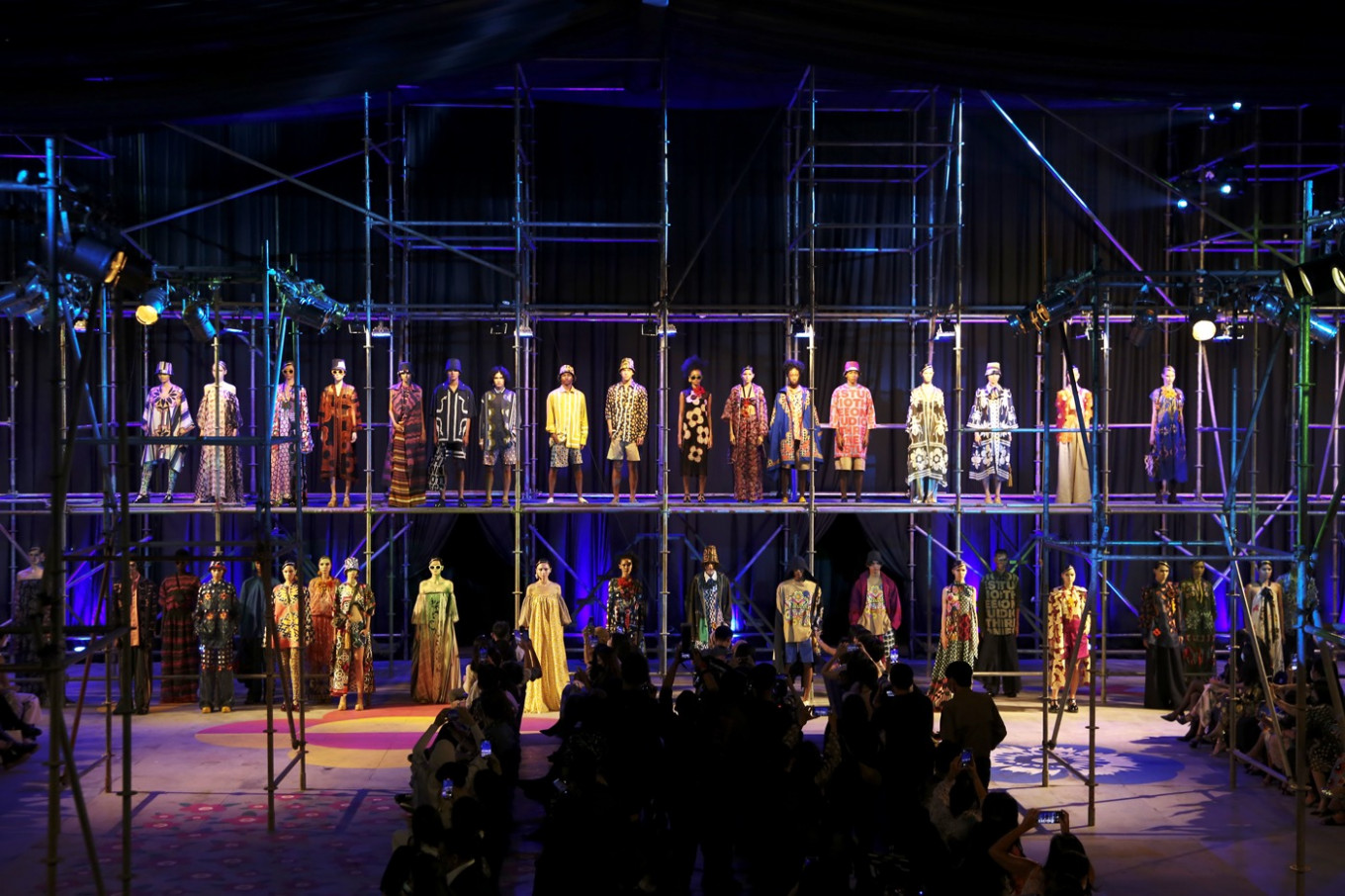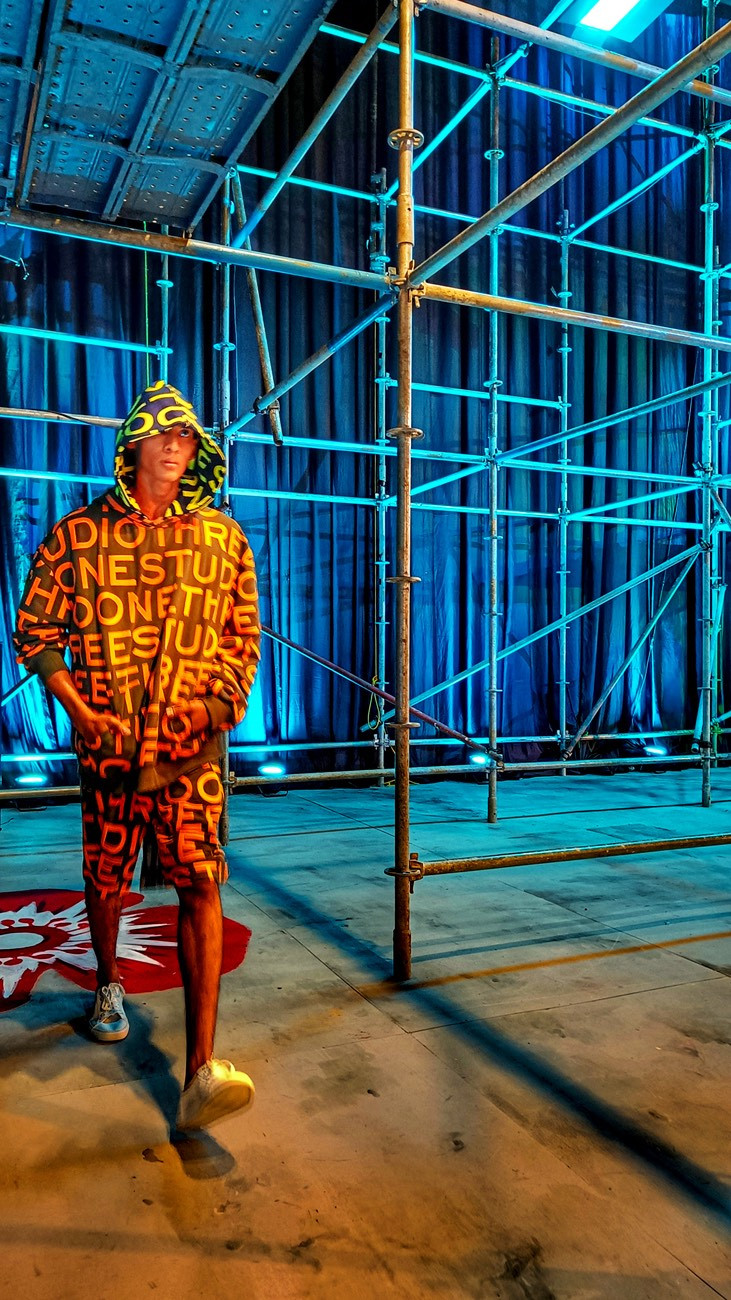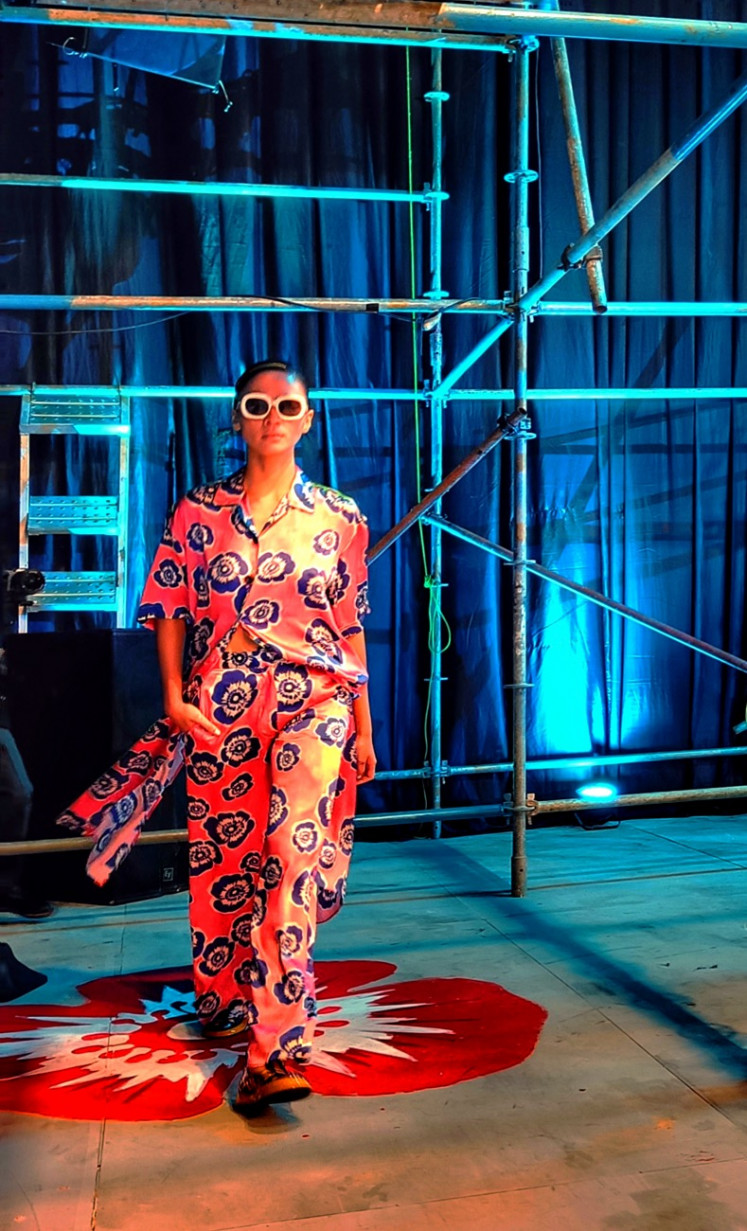Popular Reads
Top Results
Can't find what you're looking for?
View all search resultsPopular Reads
Top Results
Can't find what you're looking for?
View all search results‘Nostalgia Retrograde’: Designer Biyan’s optimistic fashion for 2023
Indonesian fashion-maestro Biyan Wanaatmadja presented an upbeat ready-to-wear collection for spring/summer 2023 and divulged his business strategies for surviving the hard times.
Change text size
Gift Premium Articles
to Anyone
I
ndonesian fashion maestro Biyan Wanaatmadja presented an upbeat ready-to-wear collection for spring/summer 2023 and divulged his business strategies for surviving the hard times.
Indonesian fashion designer Biyan Wanaatmadja presented an uplifting spring/summer 2023 collection of his second line, Studio 133 Biyan at the InterContinental Hotel Jakarta.
“The idea for the collection came from the desire to have fun after [almost] three years of being cooped up during the pandemic,” Biyan said in a press conference just before the fashion show at the hotel on Nov. 21.
“When every [interaction] was limited, my mind freely traveled, exploring many deep longings in retrospect. It was this spirit that inspired me to create the collection.”
The collection aptly themed Nostalgia Retrograde presented men’s and women’s ready-to-wear outfits that breathed the spirit of freedom of the 1960s and 1970s.
“The spirit of freedom reigned in those years,” the soft-spoken designer explained. “It was such a revival after the 1950s, in which [fashion] was so rigid and structured.”
Looking back to the 1950s, an ultra-feminine hourglass figure, with an accentuated bustline and corset-cinched waistline, was preferred for women. Dirndl dresses, cropped blouses with puffed sleeves and full-blown skirts were the fad.
In those days, men also put in extra effort to look sharp. In comparison, many younger men donned a preppy look with button-up shirts and monogrammed sweaters, and office workers mainly dressed in neatly tailored suits, ties and starched khaki trousers.
The following eras were a revolution with women ditching their corsets and adopting more uncomplicated and comfortable minidresses, flowy caftans and culottes. Men’s fashion became much more relaxed with baggy blue jeans, loose-fitting shirts and windbreaker jackets. Psychedelic prints and neon colors were also a favorite among the youth.
“It was all about the freedom to express yourself [in the 1960s and 1970s],” Biyan said. “Fashion was about wear-ability with limitless mix-and-match [possibilities] and multi silhouettes, which align with today’s elements.”
Surreal setting and practical pieces
Approximately 400 of Biyan’s loyal clients attended the fashion show held at the hotel’s grand ballroom. As the doors opened a little after 7:30 pm, the guests were treated to an unusual scene of scaffoldings lining the seats.
A haunting instrumental melody ushered in the models that sashayed in between the makeshift bamboo structures. A chorus of neon-colored spotlights taking turns to illuminate their way made the whole spectacle look surreal.
For spring/summer 2023, the label featured a series of pajama-styled outfits, reminiscent of the stay-at-home staples during the pandemic, adorned with optical-illusion patterns in rich combinations of electric hues.
The designer also gave the 1970’s boho style a remake by pairing asymmetrical tank tops and bralettes with wide-legged pants of contrasting colors and patterns, creating a suave laissez-faire impression.
The audience might also be reminded of the 1960s Flower Power as some of the models featured loose-fitted sundresses, shirts, and caftans embellished with geometric floral designs.
As if in revolt to the 1950’s discreet emblems, Biyan also introduced large monograms on oversized tops and baggy pants, giving them a sophisticated urban look.
“These pieces can easily be mixed and matched according to everyone’s taste,” the designer said. “The collection gives everyone full freedom. Just wear it the way you want.”
Biyan complemented the urbane look of his eclectic collection by pairing it with stylish Mary Jane pumps and Oxford shoes. Some of the models also wore monogrammed bucket hats and carried large totes to accentuate their outfits.
“Biyan has again proven his creativity in fashion,” Indonesian filmmaker Dimas Djayadiningrat said during a brief interview after the show. “This collection feels refreshing with its youthful designs and pop colors.”
Reminiscing stay-at-home period: A model showcases a pajama-inspired outfit with daisy patterns. (JP/Sylviana Hamdani) (JP/Sylviana Hamdani)Surviving the industry
Studio 133 Biyan was established in Jakarta in 1985.
“Studio 133 started with me and my team creating a ready-to-wear concept that had a modern traditional spirit,” the designer revealed.
Among the label’s first collections included Sumatran traditional-attire baju kurung and loose-fitted kebaya, which were the preferred outfits for young Indonesian women when attending formal events at that time.
“[The collections] were well received by the market,” Biyan said. “But over the years, customers’ [preferences] changed [to be more modern]. And we always strive to stay relevant with our customers.”
Biyan is indeed one of the most successful Indonesian fashion designers. The designer established his eponymous first line in Jakarta in 1984 and has continued strong almost four decades later.
“I’ve never dreamed of that,” the designer said in English. “Besides, who am I?”
Biyan was born and raised in Surabaya, East Java. He has always been interested in visual arts. After finishing high school, he went to study architecture in Germany, but changed his mind during the second semester.
The young man then studied fashion at Muller & Sohn Private ModeSchule in Dusseldorf and The London College of Fashion in London.
In 1984, Biyan’s parents asked him to return to Indonesia and pave a career in his home country.
Today, the designer owns and operates 11 boutiques in Jakarta and Surabaya. His collections are also available to many stockers in Asia and the Middle East.
“I don’t remember [how many] international stockers we have now,” the designer said. “There are many. And it’s always challenging to stick to deadlines and fulfill many commitments.”
The 68-year-old has weathered many challenging moments in his chosen line of career.
“Thankfully, God has been so good to me and given me so many opportunities,” he said.
At the height of the political unrest in Jakarta in 1998, Biyan received a phone call offering him to retail his collections at a multi-brand boutique in Singapore.
“It was my first time selling my collection in the international market,” he said.
However, selling in the international market has tested Biyan’s grit and determination.
“There are so many things to consider [when selling in the international market], [such as] cost-price calculations, consistency of fabric supply and quality of handmade embellishments,” the man, who was named the Best Designer in Nokia Fashion Award 2006, said.
“But there’s no return. Once you decide to be in this industry, you have to do it.”
Another hard time in the industry was when many of his employees fell sick during the COVID-19 pandemic.
“We then decided to conduct weekly PCR tests at the office,” the designer said. “At that time [the height of the pandemic], PCR testing was still costly. But we had no choice. If one of my employees got the virus [at the office] and went home [undetected], he could infect dozens of other people in their family.”
Today, the designer has more than 400 employees.
“Those that started working with me 30 years ago are still with me today,” he said. “They’re the ones that motivate me always to move forward.”
How does the designer plan to move forward in the predicted global financial crisis in 2023?
“I don’t have any plans,” he said. “I try to survive daily, year by year, by doing the best of what I can do. The rest is really up to God’s good grace.”













